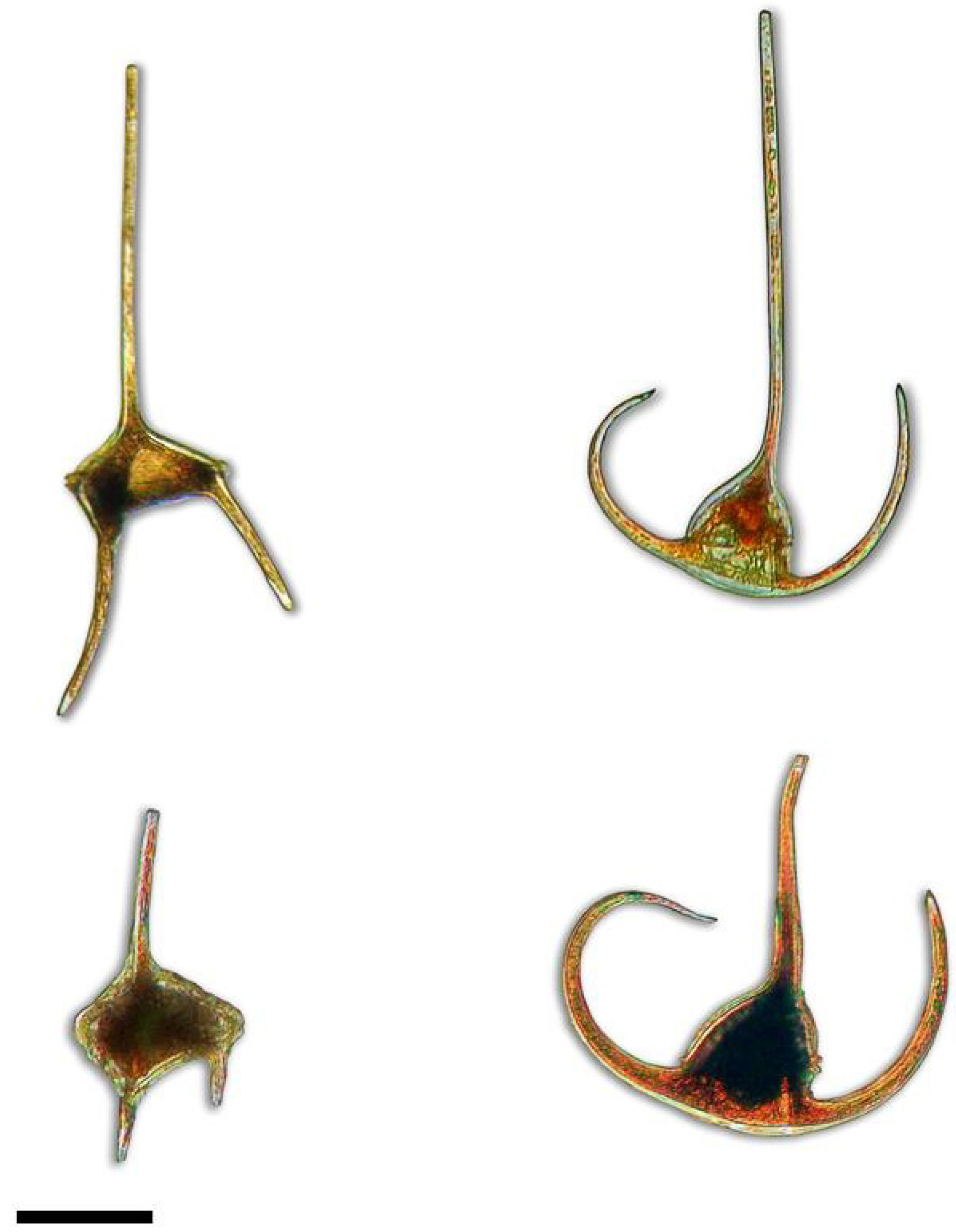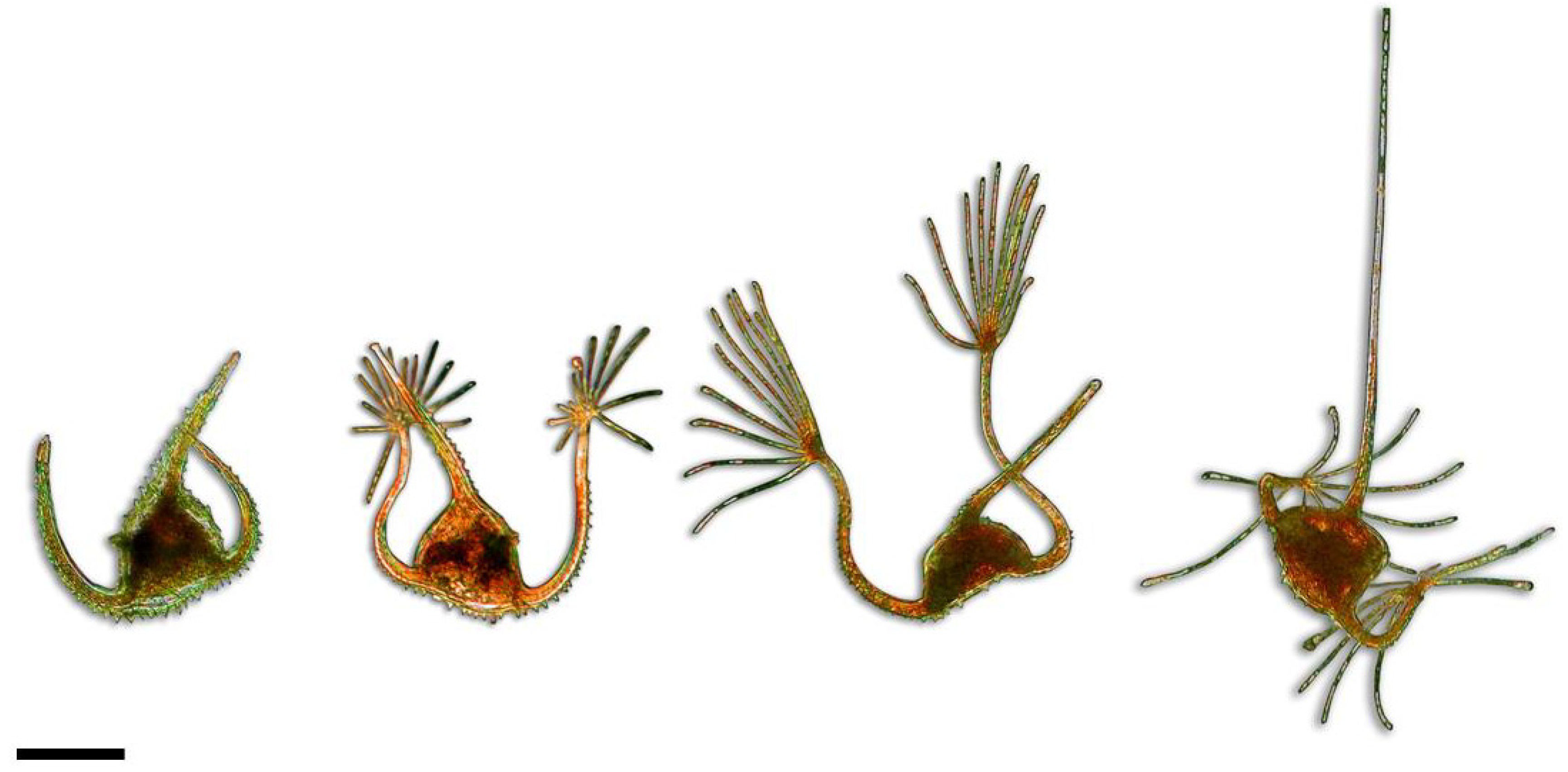The Genus Neoceratium (Planktonic Dinoflagellates) as a Potential Indicator of Ocean Warming
Abstract
:1. A Species-Rich Genus of Historical Importance
| Number of Bibliographic Records for Neoceratium or Ceratium Entries | ||
|---|---|---|
| Period | Title | Main text |
| 1950–1987 | 54 | 55 |
| 1988–2013 | 80 | 399 |
| Total | 134 | 454 |

2. A Frequent Model in Marine Research Studies
3. Investigating the Potential of Neoceratium Species as Indicators of Ocean Warming
| Prerequisites for Ecological Indicators | Neoceratium Features |
|---|---|
| Easily measured | Quick identification within phytoplankton |
| Ubiquitous, all year round present | |
| Sensitive to stress | Sensitive to change in water temperature |
| Predictable response to stress (water warming) | Appearance of warm-water species |
| Shift in seasonal pattern | |
| Northward extension range | |
| Increased abundance/prominence | |
| Anticipatory response to change | Fast response to change because of short generation time |
| Well-known response to natural and anthropogenic changes | Well-documented and well-studied genus |
| Profuse literature (biogeographical studies, presence/absence data, long-term series) | |
| Low variability in response | Low variability in response at species level |

4. Potential Neoceratium Metrics for Monitoring of Ocean Warming
5. Conclusions
Acknowledgments
Conflict of Interest
References
- Balech, E. El genero Protoperidinium Bergh, 1881 (Peridinium Ehrenberg, 1831, partim). In Rev. Mus. Argent. Cienc. Nat. Bernardino Rivadavia Inst. Nac. Invest. Cienc. Nat.; 1974; Volume 4, pp. 1–79. (in Spanish) [Google Scholar]
- Gómez, F.; Moreira, D.; López-García, P. Neoceratium gen. nov., a new genus for all marine species currently assigned to Ceratium (Dinophyceae). Protist 2010, 161, 35–54. [Google Scholar] [CrossRef]
- Sournia, A. Le genre Ceratium (péridinien planctonique) dans le Canal de Mozambique: Contribution à une révision mondiale. Vie Milieu A 1967, 18, 375–499. (in French). [Google Scholar]
- Dodge, J.D.; Marshall, H.G. Biogeographic analysis of the armored planktonic dinoflagellate Ceratium in the North Atlantic and adjacent seas1. J. Phycol. 1994, 30, 905–922. [Google Scholar]
- Gómez, F. A list of free-living dinoflagellate species in the world’s oceans. Acta Bot. Croat. 2005, 64, 129–212. [Google Scholar]
- Müller, O.F. Animalcula Infusoria Fluviatilia et Marina: Quae Detexit, Systematice Descripsit et ad Vivum Delineari Curavit; Nicholae Molleri: Copenhagen, Denmark, 1786. [Google Scholar]
- Jörgensen, E. Die Ceratien: Eine kurze Monographie der Gattung Ceratium Schrank. Int. Revue ges. Hydrobiol. Hydrogr. 1911, 4, 1–124. [Google Scholar] [CrossRef]
- Sournia, A. Classe des Dinophycées. In Atlas du Phytoplancton Marin; (in French). Sournia, A., Ed.; Centre National de la Recherche Scientifique: Paris, France, 1986; pp. 26–98. [Google Scholar]
- Sullivan, J.M.; Swift, E. Photoenhancement of bioluminescence capacity in natural and laboratory populations of the autotrophic dinoflagellate Ceratium fusus (Ehrenb.) Dujardin. J. Geophys. Res. 1995, 100, 6565–6574. [Google Scholar] [CrossRef]
- Latz, M.I.; Nauen, J.C.; Rohr, J. Bioluminescence response of four species of dinoflagellates to fully developed pipe flow. J. Plankton Res. 2004, 26, 1529–1546. [Google Scholar] [CrossRef]
- Brokaw, C.J.; Wright, L. Bending waves of the posterior flagellum of Ceratium. Science 1963, 142, 1169–1170. [Google Scholar]
- Sato, H.; Greuet, C.; Cachon, M.; Cosson, J. Analysis of the contraction of an organelle using its birefringency: The R-fibre of the Ceratium (Dinoflagellate) flagellum. Cell Biol. Int. 2004, 28, 387–396. [Google Scholar] [CrossRef]
- Elbrächter, M. Population dynamics of Ceratium in coastal waters of the Kiel Bay. Oikos 1973, 15, 43–48. [Google Scholar]
- Weiler, C.S.; Eppley, R.W. Temporal pattern of division in the dinoflagellate genus Ceratium and its application to the determination of growth rate. J. Exp. Mar. Biol. Ecol. 1979, 39, 1–24. [Google Scholar] [CrossRef]
- Weiler, C.S. Population structure and in situ division rates of Ceratium in oligotrophic waters of the North Pacific central gyre. Limnol. Oceanogr. 1980, 25, 610–619. [Google Scholar] [CrossRef]
- Pizay, M.D.; Lemée, R.; Simon, N.; Cras, A.L.; Laugier, J.P.; Dolan, J.R. Night and day morphologies in a planktonic dinoflagellate. Protist 2009, 160, 565–575. [Google Scholar] [CrossRef]
- Smalley, G.W.; Coats, D.W.; Adam, E.J. A new method using fluorescent microspheres to determine grazing on ciliates by the mixotrophic dinoflagellate Ceratium furca. Aquat. Microb. Ecol. 1999, 17, 167–179. [Google Scholar] [CrossRef]
- Smalley, G.W.; Coats, D.W.; Stoecker, D.K. Feeding in the mixotrophic dinoflagellate Ceratium furca is influenced by intracellular nutrient concentrations. Mar. Ecol. Prog. Ser. 2003, 262, 137–151. [Google Scholar] [CrossRef]
- Skovgaard, A.; Hansen, P.J.; Stoecker, D.K. Physiology of the mixotrophic dinoflagellate Fragilidium subglobosum. I. Effects of phagotrophy and irradiance on photosynthesis and carbon content. Mar. Ecol. Prog. Ser. 2000, 201, 129–136. [Google Scholar] [CrossRef]
- Raine, R.; White, M.; Dodge, J.D. The summer distribution of net plankton dinoflagellates and their relation to water movements in the NE Atlantic Ocean, west of Ireland. J. Plankton Res. 2002, 24, 1131–1147. [Google Scholar] [CrossRef]
- Ochoa, N.; Gómez, O. Dinoflagellates as indicators of water masses during El Niño, 1982–1983. J. Geophys. Res. Oceans 1987, 92, 14355–14367. [Google Scholar] [CrossRef]
- Sanchez, G.; Calienes, R.; Zuta, S. The 1997–98 El Ninõ and its effects on the coastal marine ecosystem off Peru. CalCOFI Rep. 2000, 41, 62–86. [Google Scholar]
- Semina, H.J.; Levashova, S.S. The biogeography of tropical phytoplankton species in the Pacific Ocean. Int. Revue ges. Hydrobiol. Hydrogr. 1993, 78, 243–262. [Google Scholar] [CrossRef]
- Dodge, J.D. Biogeography of the planktonic dinoflagellate Ceratium in the western Pacific. Korean J. Phycol. 1993, 8, 109–119. [Google Scholar]
- Okolodkov, Y.B.; Dodge, J.D. Biodiversity and biogeography of planktonic dinoflagellates in the Arctic Ocean. J. Exp. Mar. Biol. Ecol. 1996, 202, 19–27. [Google Scholar] [CrossRef]
- Dale, V.H.; Beyeler, S.C. Challenges in the development and use of ecological indicators. Ecol. Indic. 2001, 1, 3–10. [Google Scholar] [CrossRef]
- Tunin-Ley, A.; Labat, J.P.; Gasparini, S.; Mousseau, L.; Lemée, R. Annual cycle and diversity of species and infraspecific taxa of Ceratium (Dinophyceae) in the Ligurian Sea, northwest Mediterranean. J. Phycol. 2007, 43, 1149–1163. [Google Scholar] [CrossRef]
- Tunin-Ley, A.; Vaugelas, J.D.; Garcia, D.; Marro, S.; Lemée, R. A new collaborative web site to improve the accuracy of dinoflagellate identification: Focus on the morphologically-variable genus Neoceratium (Schrank) Gomez, Moreira et Lopez-Garcia. Cryptogam. Algol. 2012, 33, 399–404. [Google Scholar] [CrossRef]
- Margalef, R. Life-forms of phytoplankton as survival alternatives in an unstable environment. Oceanol. Acta 1978, 1, 493–509. [Google Scholar]
- Tunin-Ley, A.; Ibañez, F.; Labat, J.P.; Zingone, A.; Lemée, R. Phytoplankton biodiversity and NW Mediterranean Sea warming: Changes in the dinoflagellate genus Ceratium in the 20th century. Mar. Ecol. Prog. Ser. 2009, 375, 85–99. [Google Scholar] [CrossRef]
- Li, T.; Liu, S.; Huang, L.; Huang, H.; Lian, J.; Yan, Y.; Lin, S. Diatom to dinoflagellate shift in the summer phytoplankton community in a bay impacted by nuclear power plant thermal effluent. Mar. Ecol. Prog. Ser. 2011, 424, 75–85. [Google Scholar] [CrossRef]
- Vázquez-Domínguez, E.; Vaqué, D.; Gasol, J.M. Temperature effects on the heterotrophic bacteria, heterotrophic nanoflagellates, and microbial top predators of the NW Mediterranean. Aquat. Microb. Ecol. 2012, 67, 107–121. [Google Scholar] [CrossRef]
- Edwards, M.; Johns, D.G.; Leterme, S.C.; Svendsen, E.; Richardson, A.J. Regional climate change and harmful algal blooms in the northeast Atlantic. Limnol. Oceanogr. 2006, 51, 820–829. [Google Scholar] [CrossRef] [Green Version]
- Edwards, M.; Richardson, A.J. Impact of climate change on marine pelagic phenology and trophic mismatch. Nature 2004, 430, 881–884. [Google Scholar] [CrossRef]
- Taylor, F.J. A preliminary annotated check list of dinoflagellates from New Zealand coastal waters. J. R. Soc. N. Z. 1974, 4, 193–201. [Google Scholar] [CrossRef]
- Okolodkov, Y.B. A checklist of dinoflagellates recorded from the Russian Arctic seas. Sarsia 1998, 83, 267–292. [Google Scholar]
- Gómez, F. Checklist of Mediterranean free-living dinoflagellates. Bot. Mar. 2003, 46, 215–242. [Google Scholar]
- Gómez, F.; Boicenco, L. An annotated checklist of dinoflagellates in the Black Sea. Hydrobiologia 2004, 517, 43–59. [Google Scholar] [CrossRef]
- Hoppenrath, M. A revised checklist of planktonic diatoms and dinoflagellates from Helgoland (North Sea, German Bight). Helgol. Mar. Res. 2004, 58, 243–251. [Google Scholar] [CrossRef]
- Guilloux, L.; Rigaut Jalabert, F.; Jouenne, F.; Ristori, S.; Viprey, M.; Not, F.; Vaulot, D.; Simon, N. An annotated checklist of Marine Phytoplankton taxa at the SOMLIT-Astan time series off Roscoff (Western English Channel, France): Data collected from 2000 to 2010. Cah. Biol. Mar. 2013, 54, 247–256. [Google Scholar]
- Nagasoe, S.; Kim, D.I.; Shimasaki, Y.; Oshima, Y.; Yamaguchi, M.; Honjo, T. Effects of temperature, salinity and irradiance on the growth of the red tide dinoflagellate Gyrodinium instriatum Freudenthal et Lee. Harmful Algae 2006, 5, 20–25. [Google Scholar] [CrossRef]
- Baek, S.H.; Shimode, S.; Kikuchi, T. Growth of dinoflagellates, Ceratium furca and Ceratium fusus in Sagami Bay, Japan: The role of temperature, light intensity and photoperiod. Harmful Algae 2008, 7, 163–173. [Google Scholar] [CrossRef]
- Xu, N.; Duan, S.; Li, A.; Zhang, C.; Cai, Z.; Hu, Z. Effects of temperature, salinity and irradiance on the growth of the harmful dinoflagellate Prorocentrum donghaiense Lu. Harmful Algae 2010, 9, 13–17. [Google Scholar] [CrossRef]
- Garmendia, M.; Borja, A.; Franco, J.; Revilla, M. Phytoplankton composition indicators for the assessment of eutrophication in marine waters: Present state and challenges within the European directives. Mar. Pollut. Bull. 2013, 66, pp. 7–16. Available online: http://dx.doi.org/10.1016/j.marpolbul.2012.10.005 (accessed on 15 January 2013).
- Devlin, M.; Best, M.; Coates, D.; Bresnan, E.; O’Boyle, S.; Park, R.; Silke, J.; Cusack, C.; Skeats, J. Establishing boundary classes for the classification of UK marine waters using phytoplankton communities. Mar. Pollut. Bull. 2007, 55, 91–103. [Google Scholar] [CrossRef]
- Domingues, R.B.; Barbosa, A.; Galvão, H. Constraints on the use of phytoplankton as a biological quality element within the Water Framework Directive in Portuguese waters. Mar. Pollut. Bull. 2008, 56, 1389–1395. [Google Scholar] [CrossRef]
- Henriksen, P. Reference conditions for phytoplankton at Danish Water Framework Directive intercalibration sites. Hydrobiologia 2009, 629, 255–262. [Google Scholar] [CrossRef]
- Hays, G.C.; Richardson, A.J.; Robinson, C. Climate change and marine plankton. Trends Ecol. Evol. 2005, 20, 337–344. [Google Scholar] [CrossRef]
- Beaugrand, G.; Reid, P.C.; Ibanez, F.; Lindley, J.A.; Edwards, M. Reorganisation of North Atlantic marine copepod biodiversity and climate. Science 2002, 296, 1692–1694. [Google Scholar] [CrossRef]
- Hinder, S.L.; Manning, J.E.; Gravenor, M.B.; Edwards, M.; Walne, A.W.; Burkill, P.H.; Hays, G.C. Long-term changes in abundance and distribution of microzooplankton in the NE Atlantic and North Sea. J. Plankton Res. 2012, 34, 83–91. [Google Scholar] [CrossRef]
- Philippart, C.J.; Anadón, R.; Danovaro, R.; Dippner, J.W.; Drinkwater, K.F.; Hawkins, S.J.; Oguz, T.; O’Sullivan, G.; Reid, P.C. Impacts of climate change on European marine ecosystems: Observations, expectations and indicators. J. Exp. Mar. Biol. Ecol. 2011, 400, 52–69. [Google Scholar] [CrossRef]
- Benfield, M.C.; Grosjean, P.; Culverhouse, P.F.; Irigoien, X.; Sieracki, M.E.; Lopez-Urrutia, A.; Dam, H.G.; Hu, Q.; Davis, C.S.; Hansen, A.; et al. RAPID: Research on automated plankton identification. Oceanography 2007, 20, 12–26. [Google Scholar]
- Sieracki, C.K.; Sieracki, M.E.; Yentsch, C.S. An imaging-in-flow system for automated analysis of marine microplankton. Mar. Ecol. Prog. Ser. 1998, 168, 285–296. [Google Scholar] [CrossRef]
- Karsenti, E. Towards an “Oceans Systems Biology”. Mol. Syst. Biol. 2012. Available online: http://www.nature.com/msb/journal/v8/n1/full/msb20128.html (accessed on 27 March 2012). [CrossRef]
© 2013 by the authors; licensee MDPI, Basel, Switzerland. This article is an open access article distributed under the terms and conditions of the Creative Commons Attribution license (http://creativecommons.org/licenses/by/3.0/).
Share and Cite
Tunin-Ley, A.; Lemée, R. The Genus Neoceratium (Planktonic Dinoflagellates) as a Potential Indicator of Ocean Warming. Microorganisms 2013, 1, 58-70. https://doi.org/10.3390/microorganisms1010058
Tunin-Ley A, Lemée R. The Genus Neoceratium (Planktonic Dinoflagellates) as a Potential Indicator of Ocean Warming. Microorganisms. 2013; 1(1):58-70. https://doi.org/10.3390/microorganisms1010058
Chicago/Turabian StyleTunin-Ley, Alina, and Rodolphe Lemée. 2013. "The Genus Neoceratium (Planktonic Dinoflagellates) as a Potential Indicator of Ocean Warming" Microorganisms 1, no. 1: 58-70. https://doi.org/10.3390/microorganisms1010058
APA StyleTunin-Ley, A., & Lemée, R. (2013). The Genus Neoceratium (Planktonic Dinoflagellates) as a Potential Indicator of Ocean Warming. Microorganisms, 1(1), 58-70. https://doi.org/10.3390/microorganisms1010058




